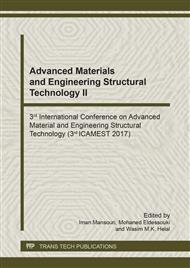p.1
p.8
p.17
p.22
p.27
p.33
p.39
p.44
Effect of GGBFS on Compressive Strength and Durability of Concrete
Abstract:
Facing the cement and concrete development process, reducing greenhouse gases and the consumption of natural resources has become an important issue. To reduce the cement content in concrete, the increased use of concrete combining large amounts of industrial by-products is expected. Ground granulated blast furnace slag (GGBFS) has been used as a supplementary cementitious material in ordinary Portland cement (OPC) concrete. In this study, GGBFS at different cement replacement ratios of 0%, 20%, 40%, and 60% by weight were used to produce concrete. Compressive strength test, water absorption, electrical resistivity, and rapid chloride penetration test (RCPT) were performed to investigate the effect of GGBFS on compressive strength and durability of concrete. Test results show that GGBFS concrete with 40% cement replacement (G40) has the highest compressive strength. The water absorption and chloride permeability reduced with the increasing cement replacement percentage by GGBFS. Meanwhile, the electrical resistivity increased with an increasing GGBFS replacement percentage. Based on the results, GGBFS concrete with 40% cement replacement seems to be the optimum replacement in this study.
Info:
Periodical:
Pages:
22-26
Citation:
Online since:
March 2018
Authors:
Keywords:
Price:
Сopyright:
© 2018 Trans Tech Publications Ltd. All Rights Reserved
Share:
Citation:


